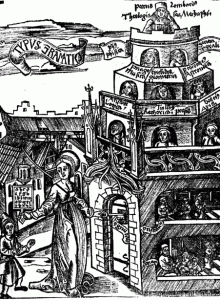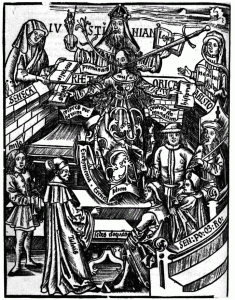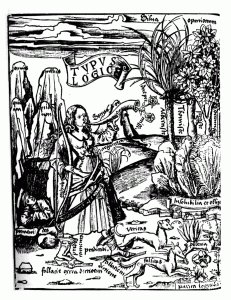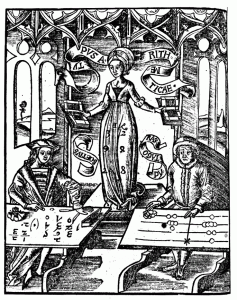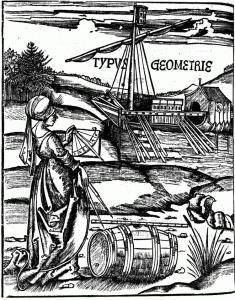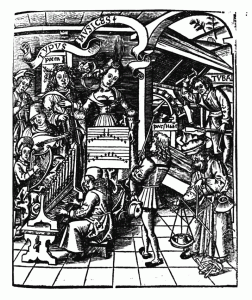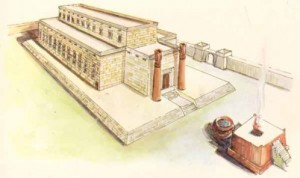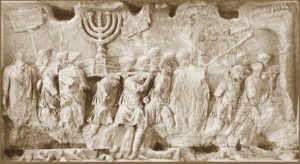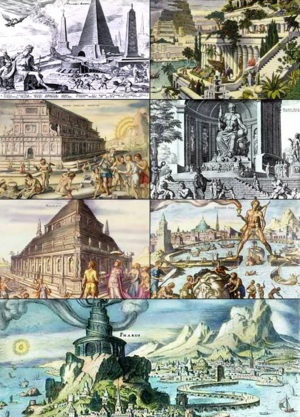The Middle Chamber
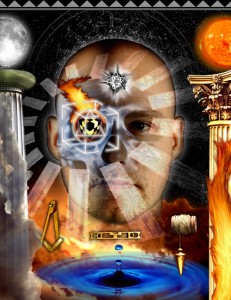
From the three steps to the five steps, we now stand at the landing of of the middle chamber. On this journey we have climbed much – traversing up Jacob’s ladder in the first degree, climbed the first series of three steps and introduced to their significance in our maturity with an introduction to the Kaballah. Then, we traversed upon the next five steps where we were illustrated the role of architecture and to our senses to take in the exoteric and esoteric undertaking of the degree. Now, before us we confront the next leg, the next seven steps that have such meaning that they can scarcely be fully understood as they are contained in their presentation.
To approach them, we must first see them as presented in context through Duncan’s Ritual and Monitor of Freemasonry as he writes of the journey:
The seven steps allude to the seven Sabbatical years, seven years of famine, seven years in building the Temple, seven golden candlesticks, Seven Wonders of the World, seven wise men of the east, seven planets; but, more especially, the seven liberal arts and sciences, which are: Grammar, Rhetoric, Logic, Arithmetic, Geometry, Music, and Astronomy
Each of these arts, as they are defined come with a specific exoteric meaning, they are what they presume to be, and by that I mean that they are in fact what we consider comparable to be the Liberal Arts of study in university today.
At first blush, seven dissonant elements are mentioned first, but our concentration must first come to focus on the latter 7, the seven liberal arts and sciences. But why study a liberal arts course of study? Harvard, a school of some esteem and founded well before Masonry organized under its present day Grand Lodge system, says of a present day liberal arts education that “A liberal education is…a preparation for the rest of life.”
It goes on to say a liberal education…
“…is, an education conducted in a spirit of free inquiry undertaken without concern for topical relevance or vocational utility. This kind of learning is not only one of the enrichments of existence; it is one of the achievements of civilization. It heightens students’ awareness of the human and natural worlds they inhabit. It makes them more reflective about their beliefs and choices, more self-conscious and critical of their presuppositions and motivations, more creative in their problem-solving, more perceptive of the world around them, and more able to inform themselves about the issues that arise in their lives, personally, professionally, and socially. College is an opportunity to learn and reflect in an environment free from most of the constraints on time and energy that operate in the rest of life.”
Though the idea of what a liberal study was at the time of their inclusion in Masonry, the principal of that study was the same. This is no subtle assertion; the creators of the Masonic degrees agreed and included in them the instruction to pursue the study of this program to better make the Mason. In short, to make the man a better man with a firm understanding of the Liberal Arts is a necessary foundation for his being.
But what exactly does that mean? To see that answer, we must look at what resides within the study of the liberal arts as instructed by Duncan’s Monitor. To do that, we need to break down what the study of the Liberal Arts would entail in its age of inclusion.
 Grammar
Grammar
The body of rules describing the properties of the English language. A language is such that its elements must be combined according to certain patterns, its morphology, the building blocks of language; and syntax, the construction of meaningful phrases, clauses and sentences with the use of morphemes and words.
The first codex for English grammar, concisely called Pamphlet for Grammar was compiled/written by William Bullokar, and was written with the ostensible goal of demonstrating that English was just as worthy and rule-bound as was Latin, and was published in 1586. Bullokar’s grammar was faithfully modeled on William Lily’s Latin grammar, Rudimenta Grammatices (1534), which was a Latin text and was used in schools in England at that time, as it was “prescribed” for them in 1542 by Henry VIII.
From early on we can see that the use of language was seen as an important necessity and that the study of Grammar and the use of language in communication of ideas to others as an important aspect of transferring knowledge.
 Rhetoric
Rhetoric
Like grammar, is the art of using language to communicate effectively and persuasively involving three audience appeals: logos which is the “reason or the rational principle expressed in words and things”[1], pathos which is the ” the quality or power, esp in literature or speech, of arousing feelings of pity, sorrow”[2], and ethos which is the ” the distinctive character, spirit, and attitudes of a people, culture, era,”[3], as well as the five canons of rhetoric: invention or discovery, arrangement, style, memory, and delivery. Along with grammar and logic or dialectic, rhetoric is one of the three ancient arts of discourse dating back to antiquity and the great works of Plato, Socrates, and Aristotle of whose surviving texts we can read today. From ancient Greece to the late 19th Century, rhetoric was a central part of Western education, filling the need to train public speakers and writers to move audiences to action with arguments rather than coercion of force.
It is the use of language in persuasion of others, an interesting Masonic application, indeed.
 Logic
Logic
With its origins from the Greek λογική logikē, is the study of arguments – Grammar and Rhetoric together. Logic is used in most intellectual activities, but is studied primarily in the disciplines of philosophy, mathematics, and computer science. Logic examines general forms which arguments may take comparing which forms are valid, and which are fallacies. It is a form of critical thinking. In philosophy, the study of logic figures into most major areas of focus: epistemology, ethics, and metaphysics. In mathematics, it takes place in the study of valid inferences within some formal language.
Clearly, we can see that Logis is the application of Grammar and Rhetoric together.
These three areas of study composed what the medieval universities called the tritium, meaning the “three roads” or “three ways” which was necessary in preparation for the quadrivium which are the next four liberal arts of ancient study. The use and preparation of this work was principally for the deeper study of philosophy and theology both noble arts in this period of the middle ages and Renaissance. The four studies came from the curriculum as outlined by Plato in the Republic, as written in the seventh book. The same quadrivium was suggested to of come from the Pythagoreans, as Proclus wrote in A commentary on the first book of Euclid’s Elements:
The Pythagoreans considered all mathematical science to be divided into four parts: one half they marked off as concerned with quantity, the other half with magnitude; and each of these they posited as twofold. A quantity can be considered in regard to its character by itself or in its relation to another quantity, magnitudes as either stationary or in motion. Arithmetic, then, studies quantities as such, music the relations between quantities, geometry magnitude at rest, spherics [astronomy] magnitude inherently moving”
 Arithmetic
Arithmetic
Arithmetic, then, is the simple day-to-day counting to advanced science and business calculations involving the study of quantity, especially as the result of combining numbers. In day to day usage it refers to the simple properties of traditional operations such as addition, subtraction, multiplication and division with small number values.
The origins of Arithmetic are thought to date back to as early as 20,000 B.C.E. from ancient tally marks on bone, however earliest records date back to the ancient Egyptians and Babylonians of 2000 B.C.E. with numeral systems and counting marks. Continuous historical development of modern Arithmetic begins in the Hellenistic period of Greece with a close relationship to philosophical and mystical beliefs such as in the works of Euclid and Pythagoras, both Masonic patriarchs.
 Geometry
Geometry
From the Greek as earth-measurement, geometry is concerned with the determination of shape, size, relative position of figures, and the properties of space. Euclid, Archimedes, Descartes, Kepler, and Pythagoras are but a few who are a part of this 5000 year old art of lengths, angles, area, and volume, of which works can be found in ancient Egypt and Babylon too. A fantastic example of their prowess we look to still today in the Great Pyramids of Giza.
The advanced study of Geometry today looks not just into the dimension and space of number, but into its correlation to physics, algebra, and string theory just to name a few as it puts to measure both the physical and invisible universe.
 Music
Music
The art of the muses, is an art form whose medium is found in the creation of sound. Common elements of music are to be found in pitch (which governs melody and harmony), rhythm (and its associated concepts of tempo, meter, and articulation), dynamics, and the sonic qualities of timbre and texture.
More than the study of melody and song, the Pythagoreans of ancient Greece were the first researchers believed to have investigated the expression of music in scale in terms of numerical ratios, particularly the ratios of small integers. Their central doctrine was that “all nature consists of harmony arising out of number”[4]
On Pythagoreans scale, the Greek Pythagorean and Presocratic philosopher
Philolaus says in Carl Huffman’s “Philolaus,”
A musical scale presupposes an unlimited continuum of pitches, which must be limited in some way in order for a scale to arise. The crucial point is that not just any set of limiters will do. We cannot just pick pitches at random along the continuum and produce a scale that will be musically pleasing. The scale that Philolaus adopts is such that the ratio of the highest to the lowest pitch is 2 : 1, which produces the interval of an octave. That octave is in turn divided into a fifth and a fourth, which have the ratios of 3 : 2 and 4 : 3 respectively and which, when added, make an octave. If we go up a fifth from the lowest note in the octave and then up a fourth from there, we will reach the upper note of the octave. Finally the fifth can be divided into three whole tones, each corresponding to the ratio of 9 : 8 and a remainder with a ratio of 256 : 243 and the fourth into two whole tones with the same remainder. Thus, in Philolaus’ system the fitting together of limiters and unlimiteds involves their combination in accordance with ratios of numbers. Similarly the cosmos and the individual things in the cosmos do not arise by a chance combination of limiters and unlimiteds; the limiters and unlimiteds must be fitted together in a pleasing way in accordance with number for an order to arise. Fragment 6a suggests that Philolaus saw the cosmos as put together according to the diatonic scale. This would be very much in accord with the famous conception of the harmony of the spheres according to which the heavenly bodies make harmonious music as they move, but neither in Philolaus nor any other early source do we get an explicit account of how the musical scale corresponds to the astronomical system.[5]
As you can see, the study of music, in its basic form of composition and in its deeper esoteric study, lends itself to the exploration of mathematics, logic, and geometry, which can lead to a better understanding of the universe itself, which brings us to the last element in this progression.
 Astronomy
Astronomy
More precisely called astrology in its earliest Western study.
Astrology and astronomy were archaically one and the same discipline (Latin: astrologia), and were only gradually recognized as separate in Western 17th century philosophy during the “Age of Reason”. Since that time the two have come to be regarded as completely separate disciplines.
Astronomy, then, is the study of objects and phenomena from beyond the Earth’s atmosphere which is a science and widely studied in academic discipline discovering the expanse of the heavens in planets, stars, and other stellar phenomena. Astrology, which uses the positions of celestial objects as the foundation for predictions of future events, and other esoteric knowledge, which is not considered a science and is often seen as a form of divination.
The early astronomer/astrologer, despite its predictive application, would use the study of celestial bodies and chart the astrological movements in space which in turn were applied to correspondences in day to day life of those who he charted them for. Many renaissance scientists were astronomer/astrologers including Isaac Newton, Galileo Galilei, Tycho Brahe, Johannes Kepler. The infamous John Dee, astrologer and Magus for the court of Elizabeth I in 1558. Its suggested that by his charts he selected Elizabeth’s coronation date. The practice was in keeping with their earlier study pattern of the liberal arts and not seen as abhorrent to their conclusions in their time.
Scoffed at in academic circles today, the realm of astrology is often the fodder for cheap periodicals and psychic infomercials. In its deeper recesses we can link it to the study of the Kabbalah and the Western mystery traditions and find parallels to our perceptions and ideas even in our Masonic symbolism. Just a quick look at the Holy Saints John again will remind us of our own pairing of earth bound ideas to the equatorial poles of our sun’s annual transition from summer to winter and back again. Perhaps this is coincidence, or by design, in either case it gives us a link to our past in the Liberal studies. This is, in some aspect of antiquity, the role of astrology and the cycle of mankind and our understanding of it.
Notwithstanding the work in Duncan’s or in more localized versions of the Work, the number seven has a deep and rich symbolic significance within many circles. Cirlot, in his A Dictionary of Symbols says of the number seven that it is “Symbolic of perfect order, a complete period or cycle…composed of the ternary and quaternary and … endowed with exceptional value.” He goes on to suggest that it corresponds to the seven directions of space and to the reconciliation of the square with the triangle – the sky over the earth. Seven is the number expressing the sum of heaven and earth.[6]
Now, as we have looked at the seven liberal arts it is necessary to turn back to the dissonant collection at the beginning of this section of steps to look at some of the other connections mentioned in Duncan’s Ritual Monitor to bring them into resonance. In this degree, Duncan mentions the seven Sabbatical years, seven years of famine, seven years in building the Temple, seven golden candlesticks, Seven Wonders of the World, seven wise men of the east, and seven planets. Briefly we must touch on what each of those things mentioned in the 7’s allude to and see if we can find any deeper esoteric meaning behind them to get a glimpse of their significance or meaning to Masonry.
The Number Seven
The Seven Sabbatical years, known also as Shmita, is the seventh year of a seven-year agricultural cycle as mandated by the Torah for the use of the Land of Israel. During that 7th year the land is to lay fallow and all agricultural activity on it stops (excluding some maintenance) and comes from the Book of Leviticus which makes promise of bountiful harvests to those who are observant:
Leviticus 25:20-22 N.I.V.
20 You may ask, “What will we eat in the seventh year if we do not plant or harvest our crops?” 21 I will send you such a blessing in the sixth year that the land will yield enough for three years. 22 While you plant during the eighth year, you will eat from the old crop and will continue to eat from it until the harvest of the ninth year comes in.
The seven years of famine stems literally from Genesis 41:30 which reads “And there shall arise after them seven years of famine; and all the plenty shall be forgotten in the land of Egypt; and the famine shall consume the land” which follows a 7 year period of great abundance. Interestingly, there are other activities in the period of the Sabbatical year, in which debts are to be forgiven as it is considered a Godly act, which becomes a component of the focus in that seventh year.
The seven years in building the Temple is clearly the story of Solomon building the temple in which…King Solomon raised up a labor force out of all Israel – and the labor force was thirty thousand men . . . Solomon selected seventy thousand men to bear burdens, eighty thousand to quarry stone in the mountains, and three thousand six hundred to oversee them. (1 Kings 5:13; 2 Chronicles 2:2). According to 1 Kings 6:38 The work of the temple took seven years saying:
“And in the eleventh year, in the month of Bul, which is the eighth month, the house was finished in all its parts, and according to all its specifications. He was seven years in building it.”
The seven golden candlesticks, literally from Revelations 1:20 (NIV) which reads
“The mystery of the seven stars that you saw in my right hand and of the seven golden lamp stands is this: The seven stars are the angels of the seven churches, and the seven lamp stands are the seven churches.”
This could, interpretively, be seen as the Menorah which is a seven branched candelabrum used in the ancient Tabernacle of Moses in the wilderness (not to be confused with the nine branched Menorah used at Hanukkah. The Great architect himself instructing Moses on the construction of the lamp in Exodus 25:31-40 a depiction of which can be found on the Arch of Titus, which is a first century Roman honorific on the Via Sacra in Rome which shows the spoils from the sack of Jerusalem.
The Menorah, when lit, was said to represent the Shekhinah, which refers to a dwelling or settling in a special sense as that of divine presence, to the effect that, while in proximity to the Shekhinah, the connection to God is more readily perceivable. Its lighting, or continual ignition, is variously representative of universal enlightenment and/or the burning bush as seen by Moses.
The temple menorah is a more likely source of Masonic inspiration as it fits with the appointments of King Solomon’s Temple, to whom Masonry holds its affinity and who’s role fits more in resonance with the purpose of the degrees.
The seven wonders of the world are very straight forward and are reflections on the impressive work of the Masons (literally stone cutters) who came before the present day lodge.
The Ancient Wonders were:
- The Great Pyramid of Giza from 2584-2561 BC in Egypt.
- The Hanging Gardens of Babylon from around 600 BC in Iraq.
- The statue of Zeus at Olympia from 466-456 BC (Temple) 435 BC (Statue) in Greece.
- The Temple of Artemis at Ephesus circa 550 BC in Turkey.
- The Mausoleum of Halicarnassus 351 BC (to which the modern AASR SJ HQ is modeled after) in Carians, Persians, Greeks
- The Colossus of Rhodes from 292-280 BC in Greece.
- The Lighthouse of Alexandria circa 280 BC in Hellenistic Egypt, Greece.
The seven wise men of the east were early 6th century BCE philosophers, statesmen and law-givers that were renowned in the following centuries for their wisdom. The title of Seven Wise Men (or Seven Sages) was the title given by ancient Greek tradition.
Each of these Sages represents a worldly aspect of wisdom, though each has varied over time, these are the most common:
Cleobulus of Lindos: he would say that “Moderation is the best thing.” He governed as tyranos of Lindos, in the Greek island of Rhodes, circa 600 BC.
Solon of Athens: he said that “Keep everything with moderation”. Solon (640-559 BC) was a famous legislator and social reformer from Athens, enforcing the laws that shaped the Athenian democracy.
Chilon of Sparta: authored the aphorism “You should never desire the impossible”. Chilon was a Spartan politician from the 6th century BC, to whom the militarization of the Spartan society is attributed.
Bias of Priene: “Most men are simply bad.” Bias was a politician who became a famous legislator from the 6th century BC.
Thales of Miletus: Thales is the first known philosopher and mathematician. He famously said “Know thyself”, a sentence so famous it was engraved on the front façade of the Oracle of Apollo in Delphos.
Pittacus of Mytilene (c. 650 BC), governed Mytilene (Lesbos) along with Myrsilus. He tried to reduce the power of nobility and was able to govern Mytilene with the support of popular classes, to whom he favored. He famously said “You should know which opportunities to choose”.
Periander of Corinth: he was the tyranos of Corinth circa 7th and 6th centuries BC. Under his rule, Corinth knew a golden age of unprecedented prosperity and stability. He was known for “Be farsighted with everything”.
Collectively, these wise men have been quoted and mentioned throughout antiquity and have been looked to as great men worthy of emulation if in their least for their thoughts.
Plato’s Protagoras is the oldest and most explicit mention of the 7 sages in which he says:
“…There are some, both at present and of old, who recognized that Spartanizing is much more a love of wisdom than a love of physical exercise, knowing that the ability to utter such [brief and terse] remarks belongs to a perfectly educated man. Among these were Thales of Miletus, and Pittacus of Mytilene, and Bias of Priene, and our own Solon, and Cleobulus of Lindus, and Myson of Chen, and the seventh of them was said to be Chilon of Sparta. They all emulated and admired and were students of Spartan education, and one could tell their wisdom was of this sort by the brief but memorable remarks they each uttered when they met and jointly dedicated the first fruits of their wisdom to Apollo in his shrine at Delphi, writing what is on every man’s lips: Know thyself, and Nothing too much. Why do I say this? Because this was the manner of philosophy among the ancients, a kind of laconic brevity.”[7]
The seven planets from classical astronomy included the Sun and Moon and the five non-earth planets of our solar system closest to the sun each visible without a telescope including Mercury, Venus, Mars, Jupiter, and Saturn. At an early point they were considered asteres planetai or wandering stars, as they were seen as non fixed objects in the night sky.
The astute observer may notice the inclusion of the Sun and the Moon as these two objects relate to the leadership of the lodge, the pillars of wisdom, strength, and beauty, and the art of Kabbalah.
As a side note, the early seven planets were the derivatives of the names of the week; in alchemy the seven metals of the classical world: gold, silver, mercury, copper, iron, tin, and lead which corresponded to the known planets.
How do we relate these 7’s to the degree is complex. Perhaps how Cirlot stated, each of these 7’s are elements of perfection: how to achieve perfection, how to live it, how to incorporate it, etc., giving us the map by which to seek it out.
With this, we have reached the top of the stair, and in having taken the journey we have learned what we can about the being of a Fellow of the Craft. As said earlier, this is a complex lot of knowledge and information to digest through the smallest of apertures as presented on a rolled out carpet as given in the degree lesson. It is assumed that the candidate would have knowledge of these esoteric things; in the sense that few would have studied them and even fewer committed them to memory, or that the candidate would seek out this information beyond their degree explanation to educate and enlighten himself as to what these various elements mean. This lesson in three parts is an offering of the latter in assumption that you, like the author, are in deficit of the former and not enlightened in the ways, means, and ideas of the deep and often obtuse ancient world that is so little a part of our modern one. Clearly, the second degree is a wealth of information, from the suggestion of the pillars of Wisdom, Strength, and Beauty as a conduit to the study of the Kabbalah, to the understanding of our senses and their physical and spiritual meaning and to the study of alchemy in its assertion of the significance of the seven planets and what we can infer from them physically as their position in the heavens affects our life. Perhaps Thales of Miletus said it best saying “Know Thyself“ as this change is the fuel to discovering the universe, both within and without. There is much more to this statement than what rests at its surface, of both the degree and of our being and, it is with some hope that this has served to educate you to that end.
Fiat LVX
Missed the series? Read:Part 1 – Masonic Symbolism on the Winding Staircase
Part 2 – Symbolism on the Winding Staircase – 5 steps upon the stair
Part 3 – Symbolism on the Winding Staircase – Seven the Magic Number

